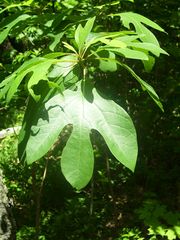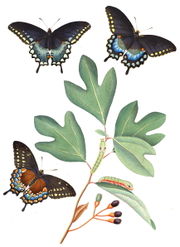Sassafras
| Sassafras | |
|---|---|
 |
|
| Sassafras albidum, Wanaque, New Jersey |
|
| Scientific classification | |
| Kingdom: | Plantae |
| (unranked): | Angiosperms |
| (unranked): | Magnoliids |
| Order: | Laurales |
| Family: | Lauraceae |
| Genus: | Sassafras J.Presl |
| Species | |
|
S. albidum |
|
| Synonyms | |
|
Pseudosassafras Lecomte |
|
Sassafras is a genus of three[1][2] extant and one extinct[3] species of deciduous trees in the family Lauraceae, native to eastern North America and eastern Asia.[2]
Sassafras trees grow from 9.1–18 m (30–59 ft) tall and spreading 7.6–12 m (25–39 ft)[4] The trunk grows 70–150 cm (28–59 in) in diameter, with many slender branches, and smooth, orange-brown bark. The branching is sympodial. The bark of the mature trunk is thick, red-brown, and deeply furrowed. The wood is light, hard and sometimes brittle. All parts of the plants are very fragrant. The species are unusual in having three distinct leaf patterns on the same plant, unlobed oval, bilobed (mitten-shaped), and trilobed (three pronged); rarely the leaves can be five-lobed.[5] They have smooth margins and grow 7–20 cm long by 5–10 cm broad. The young leaves and twigs are quite mucilaginous, and produce a citrus-like scent when crushed. The tiny, yellow flowers are five-petaled and bloom in the spring; they are dioecious, with male and female flowers on separate trees. The fruit are blue-black, egg-shaped, 1 cm long, produced on long, red-stalked cups, and mature in late summer.[1] The largest Sassafras tree in the United States is located in Owensboro, Kentucky.[6][7]
The name "Sassafras," applied by the botanist Nicolas Monardes in the sixteenth century, is said to be a corruption of the Spanish word for saxifrage.
Contents |
Species

- Sassafras albidum (Nuttall) Nees - Sassafras, White Sassafras, Red Sassafras or Silky Sassafras. Eastern North America, from southernmost Ontario, Canada through the eastern United States south to central Florida, and west to southern Iowa and eastern Texas.
- †Sassafras hesperia (Berry) Wolfe & Wehr 1987 - From the Eocene Klondike Mountain Formation of Washington and British Columbia[3]
- Sassafras tzumu (Hemsl.) Hemsl. - Chinese Sassafras or Tzumu. Central and southwestern China. It differs from S. albidum in the leaves being more frequently three-lobed,[8] the lobes having a tapered acuminate apex (not rounded to weakly acute).
- Sassafras randaiense (Hayata) Rehd. - Taiwanese Sassafras. Taiwan. Treated by some botanists in a distinct genus as Yushunia randaiensis (Hayata) Kamikoti,[9] though this is not supported by recent genetic evidence which shows Sassafras to be monophyletic.[2]
Usage

Steam distillation of dried root bark produces an essential oil consisting mostly of safrole that once was extensively used as a fragrance in perfumes and soaps, food and for aromatherapy. The yield of this oil from American sassafras is quite low and great effort is needed to produce useful amounts of the root bark. Commercial "sassafras oil" generally is a by-product of camphor production in Asia or comes from related trees in Brazil. Safrole is a precursor for the clandestine manufacture of the drug MDMA (ecstasy), and as such, its transport is monitored internationally.
Importance to livestock and wildlife
Sassafras leaves and twigs are consumed by white-tailed deer in both summer and winter. In some areas it is an important deer food.[10] Sassafras leaf browsers include groundhogs, Marsh Rabbits, and American Black Bears.[10] Rabbits eat sassafras bark in winter.[10] American Beavers will cut sassafras stems.[10] Sassafras fruits are eaten by many species of birds including Bobwhite Quail,[10] Eastern Kingbirds, Great Crested Flycatchers, Phoebes, Wild Turkeys, Gray Catbirds, Northern Flickers, Pileated Woodpeckers, Downy Woodpeckers, thrushes, vireos, and Northern Mockingbirds. Some small mammals also consume sassafras fruits.[10]
For most of the above mentioned animals, sassafras is not consumed in large enough quantities to be important. Carey and Gill rate its value to wildlife as fair, their lowest rating.[10]
Culinary uses
The dried and ground leaves are used to make filé powder, a spice used in the making of some types of gumbo.
The roots of Sassafras can be steeped to make tea and were used in the flavoring of root beer until being banned by the FDA. Laboratory animals that were given oral doses of sassafras tea or sassafras oil that contained safrole developed permanent liver damage or various types of cancer. In humans liver damage can take years to develop and it may not have obvious signs.
In 1960, the FDA banned the use of sassafras oil and safrole in foods and drugs based on the animal studies and human case reports.[11] Several years later sassafras tea was banned,[11] a ban that lasted until the passage of the Dietary Supplement Health and Education Act in 1994.[12]
Sassafras tea can also be used as an anticoagulant.
Sassafras was a commodity prized in Europe as a cure for gonorrhea.[13]
References
- ↑ 1.0 1.1 Flora of North America: Sassafras
- ↑ 2.0 2.1 2.2 Nie, Z.-L., Wen, J. & Sun, H. (2007). "Phylogeny and biogeography of Sassafras (Lauraceae) disjunct between eastern Asia and eastern North America". Plant Systematics and Evolution 267: 191–203. doi:10.1007/s00606-007-0550-1.
- ↑ 3.0 3.1 Wolfe, Jack A. & Wehr, Wesley C. 1987. "Middle Eocene Dicotyledonous Plants from Republic, Northeastern Washington". United States Geological Survey Bulletin 1597:13
- ↑ Dirr, Manual of woody landscape plants. Page 938.
- ↑ Noble Plant Image Gallery Sassafras (includes photo of five-lobed leaf)
- ↑ "Sassafras albidum". Kentucky Cooperative Extension Service. http://www.uky.edu/Ag/Horticulture/kytreewebsite/pdffiles/SASSAFRAprint.pdf.
- ↑ Whit Bronaugh (May-June, 1994). "The biggest sassafras". American Forests. http://findarticles.com/p/articles/mi_m1016/is_n5-6_v100/ai_15473433/.
- ↑ Arboretum Trompenburg: Sassafras photo
- ↑ Kamikoti, S. (1933). Ann. Rep. Taihoku Bot. Gard. 3: 78
- ↑ 10.0 10.1 10.2 10.3 10.4 10.5 10.6 This section incorporates text from a public domain work of the US government: Sullivan, Janet (1993). "Sassafras albidum". Fire Effects Information System, [Online]. U.S. Department of Agriculture, Forest Service, Rocky Mountain Research Station, Fire Sciences Laboratory (Producer). http://www.fs.fed.us/database/feis/plants/tree/sasalb/all.html#BOTANICAL%20AND%20ECOLOGICAL%20CHARACTERISTICS.
- ↑ 11.0 11.1 Dietz, B; Bolton, Jl (Apr 2007). "Botanical dietary supplements gone bad.". Chemical research in toxicology 20 (4): 586–90. doi:10.1021/tx7000527. ISSN 0893-228X. PMID 17362034.
- ↑ Kwan, D; Hirschkorn, K; Boon, H (Sep 2006). "U.S. and Canadian pharmacists' attitudes, knowledge, and professional practice behaviors toward dietary supplements: a systematic review." (Free full text). BMC complementary and alternative medicine 6: 31. doi:10.1186/1472-6882-6-31. PMID 16984649. PMC 1586212. http://www.biomedcentral.com/1472-6882/6/31.
- ↑ Horwitz, Tony (2008). A Voyage Long and Strange: Rediscovering the New World. Henry Holt and Co. p. 6. ISBN 9780805076035. http://books.google.com/?id=wiiwru-0EvwC.
External links
- Drug Digest Sassafras
- U of Arkansas: Division of Agriculture Plant of the Week: Sassafras
- GardenGuides.com Sassafras - Shrub Plant Guide
- Plants for a Future: Plant Portrait - Sassafras albidum
- TVA: Native Plant - Sassafras
- Missouri Plants - Sassafras albidum
- The Jefferson Monticello: The Lucy Meriwether Lewis Marks exhibit - article by Wendy Cortesi
- Fairfax County Public Schools: Island Creek Elementary School - Sassafras
- FossilMuseum.net: Rare Sassafras Plant Fossils